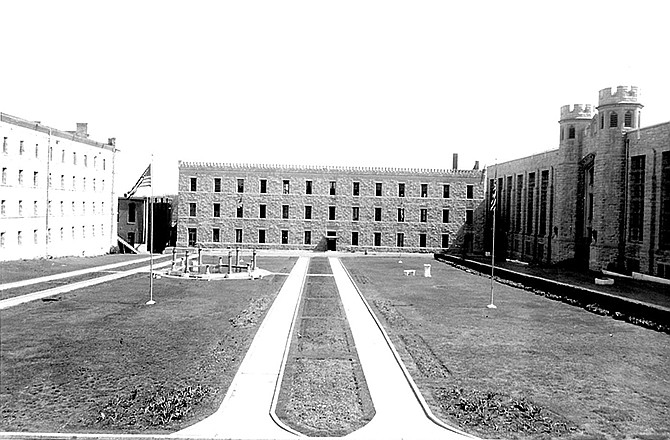Once a destination for criminals to be punished or, in some cases, put to death, the old Missouri State Penitentiary now attracts thousands of tourists to Jefferson City every year looking to get a glimpse inside the walls.
Local men James Dunnica, who built the first Capitol, and John Walker were appointed by Gov. Daniel Dunklin in 1834 as commissioners to build the facility that would be the oldest-operating prison west of the Mississippi River until 2004.
Nationally recognized architect John Haviland designed the initial penitentiary, which included the beginning of the distinctive white stone walls.
In March 1836 the prison took in its first prisoner, Andrew Jackson was president and 187 Americans died at the Alamo. The earliest prisoners were sentenced for murder, rape, horse stealing, Negro stealing, counterfeiting or highway robbery.
The Auburn system, in use when the prison opened, required silence, provided cold and small cells, administered brutal discipline, and conformed all convicts to shaven heads and striped uniforms.
In 1839 the legislature leased the prison to businessmen, putting prisoners to work to earn their keep. Many homes standing today were built with prison labor - making and laying bricks, quarrying stone or chopping wood.
William Bullard was the first prison officer murdered on duty during an escape attempt in 1841, when convicts took advantage of the other guards' being off site.
The next year, Amelia Eddy was sentenced to two years for grand larceny, but within a few day of arrival, she was pardoned for lack of adequate facilities. The second female, Martha Casto, was not released and became pregnant while there. She and her daughter remained imprisoned until pardoned more than a year after giving birth.
From the beginning, no one wanted to spend money on the site or the convicts. Early attempts at leasing the operation to private business did not work out well, ending in many inmate deaths and ultimately revolt. But the Legislature was reluctant to invest, too. In 1861 a contract system allowed private businesses to "rent" inmate work.
During the Civil War, a Union fort sat on Minor's Hill adjacent to the prison. The penitentiary shops were commandeered for troop use to manufacture equipment. In December 1865, 157 pro-Union military prisoners were released.
The prison population in 1868 was 735. With convicts working outside the walls, townspeople armed themselves as escape attempts were common.
A separate 78-cell hall for female inmates, who were issued vertically striped calico dresses, was built in 1876. Despite being vicious and hardened, a notable calm overcame the incarcerated women when Mattie Scott was allowed to bring her 4-month-old daughter with her to serve out her sentence.
In 1918, the female population was allowed afternoon outings in McClung Park, complete with a picnic meal and dancing to the prison orchestra. And in 1926, the women prisoners were moved to Prison Farm, east of MSP, where they began to can fruit and preserves. Vegetables were canned by the gallon at the penitentiary. Their housing was the Minor Mansion.
The Warden's Residence, or Marmaduke Home, at 700 E. Capitol Ave. was completed by convict labor in 1888.
The largest saddle tree manufacturers in the world operated out of the Missouri State Penitentiary. Other enterprises included the Straus Harness and Collar, Giesecke Boot and Shoe, and A. Priesmeyer Boot and Shoe.
By the 1890s, the public took more of an interest in the goings-on inside the walls. The Rev. O.W. Gauss became a full-time chaplain, and a library held about 1,600 volumes.
The Jefferson City State Tribune in 1900 declared the MSP, housing about 2,200 convicts, to be the "greatest in the world." In 1905 a National Prison Association book reported it was the only U.S. prison operating in the black, having 15 acres and 3,000 convicts.
Under the contract labor system, the grounds held five shoe factories, a saddle tree factory, clothing and broom factories, and a binder twine factory.
The growing state road system relied on inmate labor after 1926, when three work camps quarried, crushed and laid rock on the roadbeds.
Although many riots, murders and escape attempts had dotted the prison's history, the Sept. 22, 1954, event made the greatest impression.
The last execution there was in 1989.
Notable people who spent time inside the walls include J.B. "Firebug" Johnson, Kate Richards O'Hare, "Red" Emma Goldman, Harry Snodgrass "King of the Ivories," Arsenic Annie, the Young brothers, Charles "Pretty Boy" Floyd, Adam Ricchetti, Carl Austin Hall and Bonnie Brown Heady, Charles "Sonny" Liston, and James Earl Ray. Many of the Ozark Bald Knobbers did time in the the 1880s.
The site was emptied in 2004, when inmates were moved to the new Jefferson City Correctional Center east of the city.
Thousands of visitors have poured into the prison as the state has allowed the Jefferson City Convention and Visitors Bureau to conduct tours.
The site has changed considerably over the years. Buildings have gone up and come down. Most recently, administrative buildings from the original 142 acres were removed to make way for the present federal courthouse, two state office buildings have been constructed, and several buildings deemed non-historic have been razed.
The MSP was listed on the Missouri Preservation Alliance's 2010 Endangered Buildings List.
In addition to the overall prison site, the distinctive outside walls with guard towers and Housing Unit 4 or A Hall also have been named as city Landmarks. The Missouri State Penitentiary Redevelopment Commission's Master Plan also named Housing Unit 1, used today as the site entrance; Housing Unit 3; and the gas chamber, built in 1937, as the most historic of the remaining features.
Housing Unit 4, the oldest standing building, opened in 1868 on the site of the last standing original building. The four-story limestone structure, with influences of the High Victorian Gothic style, stands at the north side of the quadrangle.
Housing Unit 1, built in 1905, at the corner of State and Lafayette streets is in a C-shape and is a three-story High Victorian Gothic design. Along with a bust of Gov. A.M. Dockery, the word "Female Department" and "He who converteth a sinner from the error of his way shall save a soul from death: James-5-20" are carved into the stone.
Housing Unit 3 was completed by 1918. The three-story building faces north, sitting at the south side of the quadrangle. Two five-story, octagonal towers in the Gothic style flank its entrance.
Information for this story is from the book "Somewhere in Time" by Mark Schreiber.



